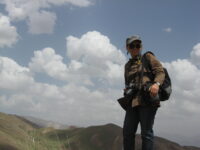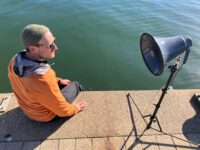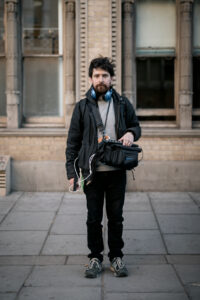News
Creatively Connected artists announced
31 October 2024
Creatively Connected
The North Pennines National Landscape team is proud to announce Creatively Connected, an arts project funded by National Heritage Lottery Fund and Arts Council England to respond to the landscape and environmental issues across Teesdale and Swaledale.
Five enquiry-based artists have been appointed as part of Creatively Connected and will work closely with the Tees Swale: naturally connected team, communities and partners to share ideas and develop creative conversations. The creative process will explore topics such as hill farming, conservation, nature restoration, environmental issues and the landscape.
The project, produced by Northern Heartlands, aims to inspire a wide range of groups to creatively connect in new ways with the environment and nature inspired by Teesdale and Swaledale landscapes.
Creatively Connected artists
Azadeh Fatehrad
 Azadeh is a multidisciplinary artist and researcher whose work bridges environmental conservation and community engagement. She employs a participatory approach, collaborating with underrepresented communities to co-create art reflecting local social and environmental challenges. Fatehrad’s work, including Nature-Based Integration and Home Away From Home, has been exhibited at the Design Biennale at Somerset House, Danielle Arnaud Contemporary Art, and Gotlands Museum among others. With a focus on themes like migration, identity, and sustainability, her practice fosters dialogue through film, photography, and installation art across international platforms.
Azadeh is a multidisciplinary artist and researcher whose work bridges environmental conservation and community engagement. She employs a participatory approach, collaborating with underrepresented communities to co-create art reflecting local social and environmental challenges. Fatehrad’s work, including Nature-Based Integration and Home Away From Home, has been exhibited at the Design Biennale at Somerset House, Danielle Arnaud Contemporary Art, and Gotlands Museum among others. With a focus on themes like migration, identity, and sustainability, her practice fosters dialogue through film, photography, and installation art across international platforms.
Azadeh said: “I’m excited about this project because it offers a unique opportunity to deepen my exploration of the relationship between communities and their natural environments. Engaging with the rich cultural and environmental landscape of the Yorkshire Dales allows me to extend my participatory approach, where art becomes a dialogue with local voices. The potential to co-create with farmers, conservationists, and other residents to reflect their stories in the artwork excites me, as it will foster meaningful conversations on sustainability and social issues. The collaborative process and its integration with local policy-making provide the chance to make a tangible impact through art, which I find deeply fulfilling.”
Tim Shaw and John Coburn

 For over 10 years, John and Tim (Wild Museum) have created collaborative artworks that connect diverse communities with ideas of Place through sound and listening. Through soundwalking, sound installations, performances, workshops and live radio events Wild Museum has engaged people in rural areas with contemporary arts practices – from farming communities to landowners, and post-industrial communities to environmentalists.
For over 10 years, John and Tim (Wild Museum) have created collaborative artworks that connect diverse communities with ideas of Place through sound and listening. Through soundwalking, sound installations, performances, workshops and live radio events Wild Museum has engaged people in rural areas with contemporary arts practices – from farming communities to landowners, and post-industrial communities to environmentalists.
John and Tim said: “We are excited to explore the Yorkshire Dales and Tees-Swale- the land and its people, its farmlands and fells, its historical trails and waterways, its caves and subterranean ecologies. Working with the wider artist and project team, we will create sound and listening interventions that inspire alternative ways of knowing these places; highlight their change and constancy; create empathy with its species and spaces; consider environmental impacts and required action.”
Laura Harrington
 Laura is a multidisciplinary artist whose practice considers the complex relations between humans and landscapes, often through experimental fieldwork, research-based and process-orientated enquiries, and in dialogue with other disciplines, habitats and people. For over 14 years, peatlands, uplands and rivers have been a regular focus of her work, embedding what she calls ‘upstream consciousness’ at the core of her practice. Working across a variety of methods and media, including filmmaking, audio visual installation, sound, drawing, fieldwork and listening, her work brings different aesthetic, methodological and ecological sensibilities into discussion. Her work has been presented at major galleries and institutions, including MIMA, BALTIC and Cittadellarte (Italy) and has been supported by a range of international residencies and commissions such as ALTER- (Switzerland) WaterLands (UK) and HIAP (Finland).
Laura is a multidisciplinary artist whose practice considers the complex relations between humans and landscapes, often through experimental fieldwork, research-based and process-orientated enquiries, and in dialogue with other disciplines, habitats and people. For over 14 years, peatlands, uplands and rivers have been a regular focus of her work, embedding what she calls ‘upstream consciousness’ at the core of her practice. Working across a variety of methods and media, including filmmaking, audio visual installation, sound, drawing, fieldwork and listening, her work brings different aesthetic, methodological and ecological sensibilities into discussion. Her work has been presented at major galleries and institutions, including MIMA, BALTIC and Cittadellarte (Italy) and has been supported by a range of international residencies and commissions such as ALTER- (Switzerland) WaterLands (UK) and HIAP (Finland).
Laura said, “I’m hugely excited about this opportunity as it focuses on an environmental context I have been embedding my practice within for the last 14 years, providing a supportive environment in which to expand and build upon this work in dialogue with a wider community. Given how inter-human and non-human relations are intrinsic to my working process, as well as having a specific interest in how artists methods have the capacity to foster new ecological understandings, I’m excited to see how this opportunity might open the potential of co-learning and developing collective based artistic practices. Specifically, in how these gatherings might play out in this environmental context. I’m interested in how this project aims to foster a unique platform for collaborative exchange, diverse dialogue and mutual learning and how people – artists, farmers, land-owners, scientists, communities, conservationists – might converge through this process.”
Matt Denham
 From the visible and invisible structures driving the climate emergency to the architecture that defines our daily lives and the values that shape our future, Matt’s practice explores shared experiences of our physical, virtual and psychological environments in a changing society. His work emerges through open and exploratory engagement with communities, practitioners and contexts beyond the arts, developing video installation, sound, digital media and textile works that reveal and connect global issues. These works often unfold in minimal, surreal environments created from domestic items, construction materials, textiles and living matter.
From the visible and invisible structures driving the climate emergency to the architecture that defines our daily lives and the values that shape our future, Matt’s practice explores shared experiences of our physical, virtual and psychological environments in a changing society. His work emerges through open and exploratory engagement with communities, practitioners and contexts beyond the arts, developing video installation, sound, digital media and textile works that reveal and connect global issues. These works often unfold in minimal, surreal environments created from domestic items, construction materials, textiles and living matter.
Matt said, “For Creatively Connected, I am looking forward to meeting and spending time with the human and more-than-human residents of Teesdale and Swaledale – with local farmers, and conservationists, landscapes and flora. This next year offers a unique opportunity to develop my recent work exploring the value of low-intensity farming systems to our natural environment. The interdisciplinary potential of this project excites me, and together with fellow artists, producers, communities and environmental organisations I hope to dig deeper into ways of encountering and nurturing the landscape to craft blueprints for the future.”


